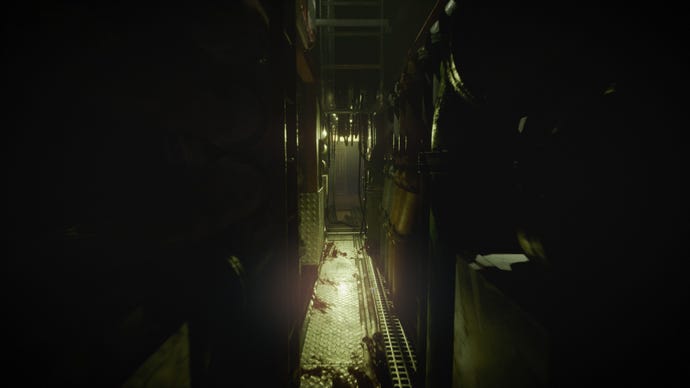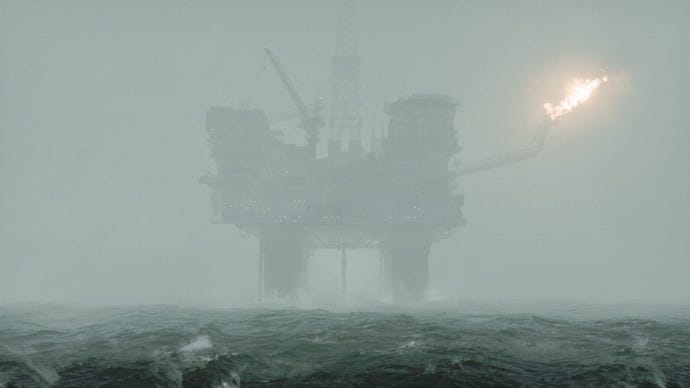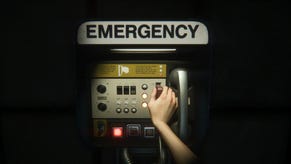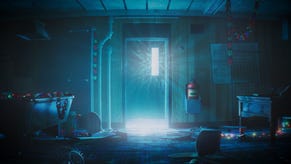Still Wakes The Deep’s authentic horror aims to channel Ken Loach by way of Stanley Kubrick
“In obscurity comes horror,” says lead designer Rob McLachlan
Set in 1975 on an oil rig in the Scottish North Sea, horror game Still Wakes The Deep is less about supernatural events, and more about the people who experience them. Here, that’s Scottish electrician Caz McLeary and the crew of the Beira D rig. In bringing the rig to life, The Chinese Room turned to archival footage, oil and gas legislation, blueprints, and photographs. For lead designer Rob McLachlan, though, it was conversations with former platform workers that painted the clearest picture of what life on the rigs was really like.
“There were two main things that were, for me, the most meaningful,” says McLachlan, “One was the isolation. Some of the people we talked to, it was like them talking about being in the army, because they felt like the were. They had a real sense of camaraderie, of professionalism. They were all operating at the limits of engineering.”
The other detail that stuck with him, says McLachlan, was “their description of the senses.” There was, said the workers they spoke to, always machine noise. Turbines. Drilling. Pumps. Fans. A constant cacophony. It’s these details that the team tried to bring into the “before the event” feeling of the rig - prior to the more overt horror you’ll encounter in the game.
“When you open a door, you get that gust of wind in your face, that sound of the deck and clanking metal and people shouting and work being done, but then you have this lovely contrast where after the event, we can dial that down,” McLachlan explains. “Suddenly things go quiet and you realise that you just hear the wind and the waves and all the machines have died down and you think; wow, this whole rig is dying. Sinking into the sea.” McLachlan doesn’t claim that they got everything right, but the aim was to get as a close as possible to the genuine experience, so that someone who's been on a platform would recognise it - even if liberties have been taken for it to all work in a game.
Still Wakes The Deep is, says McLachlan, “a return to what The Chinese Room is known for,” a story-first, tightly paced horror game. “It's a game that's designed for people to complete it, and it's a game that we've consciously created an atmosphere of both authenticity and humanity.” I’m interested in completion being enough of a design goal to merit mention. Surely, all developers would like players to finish their games.
“You can't help but be dismayed sometimes when you look at, even something as basic as achievement stats on many games,” McLachlan says - though there are games he's played where, despite respecting what they're trying to do, he feels he's seen everything after a certain point. Still Wakes The Deep, then, is approximately six hours long, intended to be played over a couple of evenings.

McLachlan says that it's “crafted to pull you through from chapter to chapter so you don't forget what you're doing. It's not a punishing experience, so it's not something where you feel like it's just luck or relentless perseverance that's getting you through, but it's more the story carrying you.” To support this, the game includes a story mode, so you can experience it without the hassle of dying. But the team still took steps to maintain tension, even without the fear of tangible consequences.
McLachlan thinks that the core of any survival horror or systemic game is in “that kind of mechanic in where the player is balancing demands.” In this case, that’s threats like dwindling oxygen, being eaten, falling, drowning, or becoming cold or exhausted. “We’ve brought all those things into the experience in a way that we feel chimes in meaningfully to the story,” he explains. “We ensure that it's a thrilling experience with the fear of death, but without that kind of relentless reloading and retrying that I strongly feel punctures the story of its momentum and its authenticity, really.”
The team also added some random elements, which keeps things surprising even to developers who might get a bit blasé when they know what's going on under the hood of their horror game. But randomness also runs the risk of some players on either end of the bell curve having it either too difficult, or too easy. “What we've spent time doing is crafting the encounters. We want everyone to be chased at that moment. We want everyone to have that surprise,” McLachlan explains. “So we we bake those moments in, but we still keep that procedural wild card of the monsters in the game. They do have a mind of their own, and they can go and do different things.” He mentions games the team admire, like Alien Isolation and Amnesia: The Dark Descent, but says that Still Wakes The Deep is tuned more towards an engaging story than pure procedural terror.

Then there’s the sea itself, which McLachlan says was always intended to be the game’s second enemy. “Even going back to the history of the UK, the North Sea has been really important; socially, economically and culturally,” says McLachlan, “Scotland was the gateway to the North Sea.” It’s quite a shallow sea, but with very large waves, and it's cold and windy, even before you get to the social challenges. “You leave your family for weeks or months at a time, and you're on your own there. It's almost like going on a warship, really, or a submarine, where although you can phone home, you're stuck there,” McLachlan tells me. “That's a really interesting setting for a horror game.”
But Still Wakes The Deep is a period game, too, and I wanted to know why the team chose to set the game in the 70s rather than present day. There were two factors at play there, explains McLachlan. The first is technology. McLachlan points out that working on the rigs now is much safer: theres always a service ship and attendant; GPS; better radio links; better safety in general. Instead, they wanted to take things back to when a lot of these precautions weren’t fully implemented, so “we could play a little bit around it being more dangerous, make it make more sense that things go so badly wrong without it.”
The second factor was down to the what McLachlan calls the “cinematic and stylistic atmosphere we wanted to make.” He says studio art director and project creative director John McCormack and associate art director Laura Dodds did “a massive amount of work on this, talking about the films from the 70s.” Influences cited include Abigail's Party, Care, movies by Ken Loach, and That Sinking Feeling. “We got photos of Porridge with Ronnie Barker and photos of actors from the 70s. That whole feeling of ordinary people, there was something beautiful about that, with working class actors who looked like characters,” McLachlan says. “It was the heyday of the character actor, when the people you saw on screen, they really looked people that could be on oil rigs.”

McLachlan says one of the taglines for the art was “what if Ken Loach started making a movie then Stanley Kubrick took over. Pushing that kitchen sink realism out into a cosmic - people get cross at me if I use ‘cosmic horror’ - but pushing it out into a realm of experience that’s completely alien.”
So, what does that (not) cosmic horror look like in Still Wakes The Deep? If you’ve seen the latest trailer, you’ll know things get grisly, but the team still wanted to maintain a sense of the unknown and unknowable. “In obscurity comes horror,” explains McLachlan. “It's the not being quite able to see something and allowing the player to infer and fill in the gaps themselves with their own worst fears. We use things like fog, mist, and darkness to feel that obscurity. But at the same time, we wanted there to be a starkness to the horror, that you go: 'Wow, this is really happening.'”
“One of the reasons that people get activated by horror,” he continues, “is to go, 'Oh, that's a human body, something horrible has happened to it.' It ties into deep brain things like the fear of disease, the fear of death. It's part of the major key of horror to have that body horror, but things that we admired were the treatment of the movie Annihilation as an example, where the horror - although its sometimes gruesome - there’s a beauty to it. There’s an alienness and starkness.”

McLachlan did say that the team intended Still Wakes The Deep to be a return to the sort of games The Chinese Room are known for. But The Chinese Room of today, for all intents and purposes, aren’t the same studio that made its name with games like Amnesia: A Machine For Pigs, Dear Esther, and Everybody’s Gone To The Rapture. In 2017, the studio laid off their development team and went dark, before being bought by Sumo Group in 2018. In 2020, they released cinematic platformer Little Orpheus. More recently, it was announced last year that they’d taken over development of the troubled Vampire: The Masquerade - Bloodlines 2 from Hardsuit Labs. So what does it mean to make a classic Chinese Room game in 2024?
“Speaking personally, when the chance came up for me to interview to and join The Chinese Room, this is the kind of game I wanted to make,” says McLachlan. “This is the game I joined The Chinese Room to make, and I think that carries across a lot of the team as well. We wanted to make a game that carried on the legacy of this sense of authenticity, Britishness, being true to a cultural and human atmosphere in a story, but to bring it into a type of game that as many people as possible will experience.”
“So,” he continues, “I don't want to use any pejorative terms that might reflect badly on our legacy. We want as many people as possible to play this game, and if if that means that we bring more interactivity, more mainstream ideas about what a game should be, then, that for us is a good thing. It means more people experience our story.”
Still Wakes The Deep is out on the 18th of June, 2024.






